Even though you may be aware that cotton and wool-based fabrics make up an important part of daily life, you may not realize that blends from these fibers and others have very different responses to fire.
No matter whether you are concerned about surviving a house fire, a mega-fire, or some other fire-related emergency, knowing more about these fabrics and fibers they are composed of is very important.
Knowing which cotton or wool blend fabrics are less flammable can you help you to make better decisions when choosing everything from drapery fabrics to garments for you and your family. While you may still need to choose more flammable materials because they have other qualities of interest to you, having less-flammable options on hand can still be a lifesaver. While this article focuses mainly on wool and cotton fabrics, there are also several others, including fire retardant specialty fabrics that you may want to learn more about as time goes by.
Flame Resistant vs. Nonflammable
Before getting into material types, there are two terms you will see in this article that look similar but mean different things. It is important to keep this difference in mind so that you have a better idea about what each material will do when exposed to a fire.
- Flame resistant or flame retardant materials are hard to ignite, burn very slowly when set on fire, or will go out when the heat source is removed. If you are wearing garments made of these materials, it may give you a few additional seconds to take them off and avoid more severe injuries. Unfortunately, these fabrics will only protect you from relatively low-temperature burning, and not the kinds of temperatures associated with a burning building. Insofar as care, garments or other items made from fire retardant materials may require special laundering to maintain the fire retardant effectiveness. Product labels should tell you what kinds of detergent and cleaning methods to use. If you still have questions contact the product manufacturer.
- Nonflammable materials even though flame-resistant materials will block a good bit of heat from reaching your skin, eventually they will fail when exposed to enough heat for a long enough time. Nonflammable materials will take longer to fail. While the difference may only be a few seconds, it can still mean an enormous difference in certain situations. Unfortunately, nonflammable materials are also very tightly knit and tend not to allow for good air circulation or release of heat from inside the garment.
Reading Textile Labels
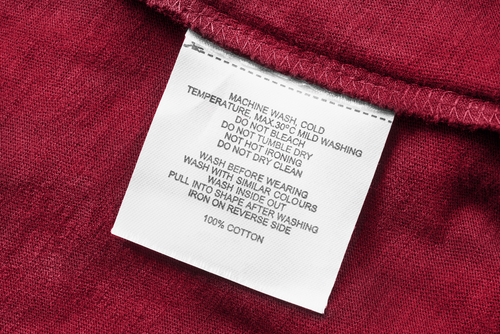
Even though you may come across a number of terms related to how fabric behaves when exposed to heat or fire, there is no such thing as a fabric that is totally fireproof. Given enough time and the proper conditions, they will all burn. That being said, there are some fabrics that resist fire more than others. The resistance may be natural, or inherent such as in the case of wool fiber. Alternatively, treatment with chemicals can make otherwise flammable materials less resistant to fire.
Today, there are dozens to thousands of different kinds of fabrics and fabric blends to choose from. As long as the product manufacturer uses accurate labels, simply reading the textile label can give you enough information to determine how the fabric will react during a fire or when exposed to certain levels of heat. Here are some things you might find:
- If the labels state flammable, inflammable, or combustible, the fabric will burn readily.
- Fireproof, non-combustible, or non-flammable notations on a label mean the fabric will not burn unless the temperature rises beyond a certain level.
- If the labels say fire resistant, fire retardant, flame resistant, or flame retardant, then it will be slow to ignite, may burn more slowly, or may be self-extinguishing when the heat source is removed.
- If the clothing label does not mention anything about fire-related properties, it is safest to consider it flammable. Should you decide to purchase these products, you can always do a flame test, later on, to see how it responds to fire. Do not forget to test pieces of lining or anything that looks different from other parts. Remember, even a small accent piece on a collar or edging can cause a disaster.
Can You Always Trust a Label?
In these times, it is very easy to try and take as many shortcuts as possible when evaluating any given product. While labels can be helpful, they can also be grossly inaccurate. Here are some problems that you may encounter:
- Depending on the situation, an inaccurate label may be a simple mistake made by the manufacturer.
- A number of manufacturers that assemble garments or other products from various materials may simply copy the label information from the raw materials onto the new product. The fire-related ratings from the original manufacturer only refer to the testing done at their facility. By the time the second, tertiary, and beyond manufacturers use different threads to assemble the product, adds various chemical treatments, use different dyes, or even combine one textile with others, the finished product may or may not be as fireproof as the original materials that came from the first factory. This is an important reason to always do a burn test unless you are buying specialized gear that has been tested as a complete unit and has the appropriate information for each fabric or fiber used in the construction of it. Needless to say, if you are buying specialized gear secondhand, you are still taking a risk because there is no way to know how the items were cleaned and cared for by the previous owner(s).
- In other cases, certain companies may disguise the nature of the materials used in order to draw a larger population of buyers. This, in turn, means that you must have some basic ideas about different fabric types so that you can evaluate them independently of the label.
Some Things You can Learn From Looking at the Product Itself
If you love prowling around flea markets, second-hand stores, or other places where labels may have worn off long ago, then you will need to use other methods to figure out what will happen to the item if exposed to a fire. Here are three things that are easy to assess no matter what kind of material you are looking at.
- Weave and Weight Considerations – In general, lighter weight fabrics with looser waves allow more oxygen to get in between the fibers and circulate around them. This, in turn, makes it easier for them to ignite. On the other hand, fabrics with a light weave such as wool, modacrylic, 100% polyester, and those that have been Ame retardant treated will burn more slowly because there is less oxygen available.
- Surface Texture – Fluffy, loose, furry, plush, or other pile type textures will ignite easily and flames may race right across them. This is very different from materials that have smoother textures, as there is less oxygen availability at the burning surface.
- Garment/Product Design – In one sense, garment design is similar to evaporation in the sense that more surface area leads to increased exposure to oxygen. This, in turn, means that long, full, or loose garments will ignite faster or burn more readily than smaller garments made of the same material. Aside from that, loose or flowing garments may be more likely to encounter a heat source if you aren’t paying attention or don’t realize that danger is near.
What is a Fiber and What Kinds are Available?
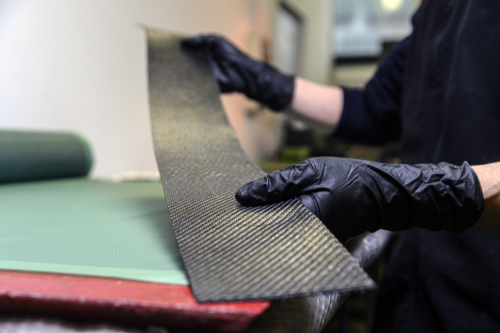
A fiber is defined as the smallest unit of fabric. While most fibers aren’t much thicker than hair, they can extend from just a few inches to several yards in length. Multiple fibers are spun together to make thread or yarn. Depending on how the fibers compact during the spinning process, threads and yarns can be fairly thin or very thick. The finished yarn or thread can also be smooth with well-defined threads or coarse and bulky. In order to make fabric, multiple threads are woven together so that they create a larger surface area.
There are two basic types of fibers used in textiles: natural and synthetic. Flammable or non-flammable aside, there are some other things you should keep in mind about each basic category.
An Introduction to Natural Fibers
The most common natural fibers include cotton, fur, silk, linen, and wool. Depending on the methods used to preserve the fiber or make it waterproof, chemicals such as formaldehyde may or may not be needed.
Even though all of these fabrics will burn, some will do so faster and more readily than others. For example, untreated fibers used in lightweight fabrics such as linen, silk, and cotton will ignite easily, while wool is harder to ignite and takes longer to burn. Since these fibers do not melt or shrink away from the fire, they will also feed the fire and give it more fuel to kindle other materials around them at a much faster rate. Fires that consume linen and cotton will also produce a significant amount of smoke.
Cotton vs. Wool From a Flammability Perspective
Aside from the fact that cotton will burn faster than wool, here are some other key differences to consider:
- Cotton can be successfully treated with fire retardants that will reduce its capacity to continue burning once removed from a flame. Unfortunately, there are many long term health hazards associated with the use of fire retardants. From a pure flammability perspective, you would be best served by avoiding cotton and cotton blends
- Wool is more fire retardant than cotton, but it will still burn. Wool will also shrink from a flame and will not melt. Since wool smells like hair burning, there is no mistaking when it is on fire! Usually, wool will burn slowly and will leave behind a black gritty powder, and is self-extinguishing.
In order to understand more about the flammability properties of materials that include cotton and wool, it is important to learn more about other fibers that can be mixed with them and their properties when exposed to fire. This includes situations where another fabric type might be used as a liner or as an accent to the main fabric. Here are some common ones that you might come across when reading labels for textile products, and some things to remember about them:
Furs And Leather
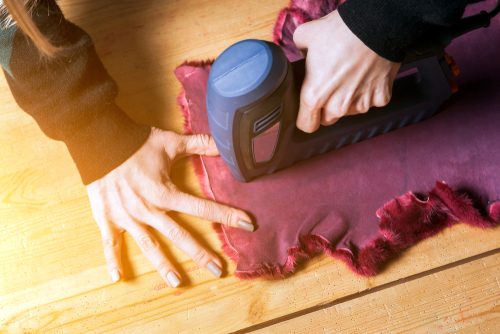
There are three basic kinds of fur and leather. The first kind is taken from wild animals that are trapped and hunted. In a time of need, you can use brain tanning and other natural methods to prepare the hides for making garments and other needs. Furs and leather prepared as they were hundreds of years ago will still be flammable, however not as bad as the second kind that is available on the market these days.
The second kind of fur and leather is usually what you see in the stores. Animals are raised on commercial farms where they are anally electrocuted; or in China, the animals may be hung up from wire and literally skinned alive. Leather is often a byproduct of the food production industry. Both fur and leather may be treated with carcinogenic chemicals such as formaldehyde. No matter whether these chemicals, including some fire retardants, leach through your skin, or you smell them in the air, they can wreak havoc on your health. Needless to say, if fur or leather isn’t treated with a fire retardant, you are right back to wear something that can go up in flames before you have a chance to get it off your body.
Finally, the third kind of fur may or may not be made from natural fibers. It may be made from a blend of natural and synthetic fibers and then processed in order to achieve textures similar to real fur and leather. Depending on the fiber blend, these fabrics may or may not be more flammable than others. Unfortunately, you can’t rely on what you read on the label. A significant amount of “fake fur” on the market today “made in China”, is actually made from cats, dogs, and rabbits. If you purchase fake fur because you think it is made from a fiber that is less flammable than a natural fiber, it can cost your life if you wind up in a fire. Aside from wrong information about the actual fibers used, there is no telling what kind of flammable chemicals may have been used to process the fibers and the amount of residue left in the final product.
With regard to purchasing any textile product with anything that looks like fur on it, you are taking an enormous risk in terms of flammability. It does not matter if the other materials are made of wool or cotton treated with a fire retardant. The inability to determine what the furry material actually is can leave you in a situation where this material will burn easily and may just produce a hot enough fire to make surrounding textiles burn easily.
Linen
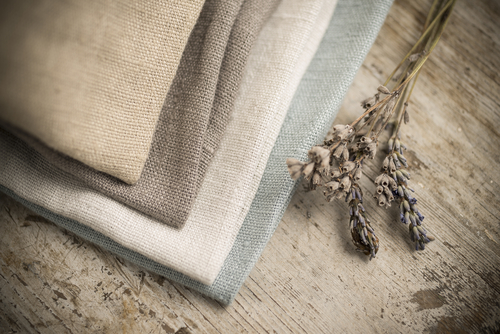
Linen is made from flax plant fibers. It is very popular and has been used for a long time because of the flax plant that grows well, and sustainably worldwide. While it produces a very comfortable, breathable fabric, it also ignites easily. Even if you remove it from the flame source, it will continue to burn and produce fine gray ash. There are fire retardant chemicals that can be applied to linen, however, you should be aware of their potential impact on your health. Overall, it is best to avoid cotton/linen blends for drapes or other textiles that need to be as fire retardant as possible. Unfortunately, it is very difficult to avoid cotton/linen blends for sheets and clothes. Just be aware of the risks involved in using these blends, and if possible, look for synthetic fibers that have a better fire safety rating.
Silk
Silk is an animal protein-based fiber produced by insects such as silkworms during the process of building cocoons. Although silk is relatively cheap and easy to manufacture, its softness and beauty make it valuable. Insofar as fire-related concerns, silk ignites quickly and burns easily. It will shrink from flames and produce a black powder as it burns. Thicker fabrics will burn slower, and eventually, the fire will burn itself out. When compared to cotton or linen it may be more dangerous from a fire-related perspective because of the dyes and additives that may be more flammable than the fabric itself. Because silk is often produced in regions with harsh economic conditions, there are no set standards that make it possible to determine just how flammable any given garment will be. As beautiful as silk and silk blend are, avoid using it in areas where the fire is a concern.
Hemp
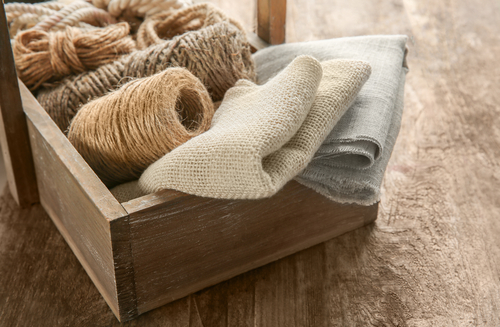
Hemp fabric is made from the fibers of a plant found in the cannabis family. Although it is related to the same plant used to make marijuana, it has far less of the main psychoactive ingredient, THC. Hemp is similar to flax in the sense that it grows quickly and well in most parts of the world. It will also produce more vegetation per acre than cotton or flax. Even though fabric made from hemp is durable, lightweight, and absorbent, it is also every bit as flammable as materials made from flax and cotton. Hemp ignites easily, will not shrink from the flame or melt, and will also continue to burn when removed from the fire. There are also fire retardant chemicals that can be used to make hemp fabrics more resistant to burning.
Jute
Jute is a natural fiber. It’s one of the most affordable natural fibers and is second only to cotton in quantity produced and variety of uses for plant fibers. It is harder than other textile fibers and is environment friendly. Jute fabric has excellent tensile strength and more forgiving to airflow making it highly breathable. Normally jute is used for sacking, burlap, and twine, but can also be used in the clothing industry. Jute burns, but doesn’t melt, has the odor of burning paper or wood, and leaves black ash.
Synthetic Fibers
Synthetic fibers are man-made from chemicals. The synthetic fibers are broken down into three categories regenerated, man-made synthetic polymers, and other man-made synthetics not made of polymers. Most synthetic fibers will melt as opposed to burning. They can still leave behind very serious burns if the material touches your skin during a fire.
Regenerated Fibers
Regenerated fibers are natural that has been mixed with chemicals to make materials that have been processed into a fiber structure.
Rayon and Lyocell
Rayon and lyocell rank beneath linen and cotton as the most flammable fabrics in your home. A well-known characteristic of these fabrics is that they have a tendency to melt slightly when exposed to flame and smell a bit like burning paper or wood. If you are wearing these fabrics, or get near then when they are hot enough, the fabric might stick to your skin and cause serious burns. As with cotton and linen, lyocell, and rayon fabrics that are tightly knitted will still be highly flammable, however, they will also be more flame resistant than more loosely knit fabrics from the same material.
Acetate And Triacetate
These materials are made from fibers known as regenerated man-made material. Acetate and triacetate are synthesized when purified cellulose from wood pulp reacts with acetic acid and anhydride in the presence of sulphuric acid. When exposed to fire, these materials or blends of them may flare up quickly, and then melt as they go on burning. While they are burning, they may also produce a vinegar-like odor, and leave behind hard beads of black material. Overall, they are similar to cotton and linen insofar as their fire hazard level.
Man Made Synthetic Polymers
Most synthetic fabrics, such as nylon, acrylic, or polyester resist ignition. Unfortunately, once they do catch fire, they have a tendency to melt, which can cause severe burns if they touch your skin. To add insult to injury, when combined with natural fibers, the natural fibers will increase the temperature of the material and provide more flame support, and ultimately make the fabric more dangerous than either of the other fabrics by themselves.
Polyester
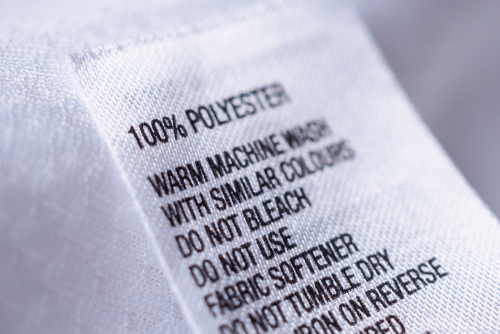
This material is used in all types of clothing, home furnishings, and as a reinforcement fiber in tires, belts, and hoses. The new insulating polyester fabrics are used as fiberfill in high-performance outdoor wear.
Polyester melts and burns at the same time when exposed to high heat then retreats from the flame. While burning, it generates black smoke, gives off a chemical or sweet odor, and then leaves behind a dark residue. These materials can cause very bad burns or death if you are exposed to the material while it is burning and melting.
Acrylic
The key ingredient of acrylic is acrylonitrile also called vinyl cyanide. This substance is a carcinogen and a mutagen that targets the central nervous system. According to the CDC, acrylonitrile can enter the body through skin absorption from wearing garments made of acrylic fabric, as well as via inhalation or ingestion. Acrylic tends to be slow to ignite, but once ignited burns rapidly. It will also produce a lot of melting, and dripping occurs that can cause severe burns or death.
Nylon
Nylon is an artificial fiber made of polyamide which contains carbon, oxygen, nitrogen, and hydrogen. High filament nylon yarns are often blended with spandex and used in athletic apparel, swimwear, and hosiery. Nylon melts, then burns. It will retreat from the flame, burns slowly, and forms a dark color bead after it has completely burned out.
Man Made Synthetic Fibers, Not Made Of Polymers
Metallic Fiber
These manufactured fibers are made of a combination of metal and plastic. Depending on the composition of the plastic, it may or may not be highly flammable. In most cases, however, the sealant or covering will resist salt water, chlorinated water, and various climate conditions. Sealant flammability aside, you should never wear metallic fibers when undergoing an MRI. The metal in the fabric will heat up and can cause other fiber types in the fabric to catch fire.
Even though gold and silver have been used throughout history to make decorative yarns for garments and other purposes, the ancient forms were not encased in plastic. Recently, aluminum yarns, aluminum-plastic yarns, and aluminized nylon yarns have replaced gold and silver for making decorative metallic yarns.
Surprisingly enough, there are many uses for metallic fibers. The most common fibers are lame’ and brocade that is used in upholstery fabric and in textiles. Metallic fibers are also being used more in clothing today to add strength and durability. To help reduce static electricity in carpets, stainless steel fibers are mixed with other fabrics to help reduce the static shock. These fabrics are also used in protective suits, space suits, and cut resistant gloves for individuals working with very sharp knives and other tools.
Glass Fiber
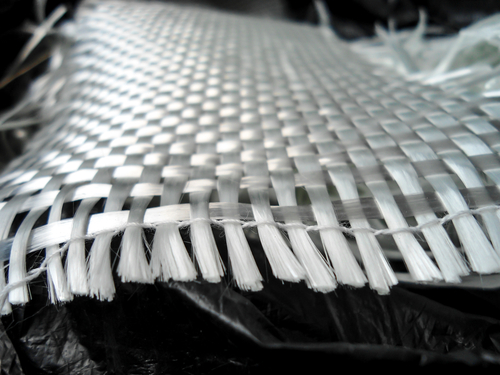
Glass fiber is also known as fiberglass. These materials are both fire resistant and fire retardant. In order to make fiberglass fabrics more durable, they are usually combined with polyester or vinyl ester resins or epoxy. The degree of fire resistance will depend on the characteristic of the resins used. As you may be aware, some resins are flammable even when cured, while others can withstand fairly high temperatures without burning or melting.
Carbon Fiber
Carbon fibers tend to have a high-temperature tolerance. They can be used alone, or woven along with other fabrics to make composite materials. Aside from being used in clothing oriented textiles, they are often blended for use in electric blankets and other flexible heating devices. Unfortunately, if heating elements are included in the material, excess heat can build up and cause less fire-resistant materials to reach their kindling point and burn.
Basic Steps for Doing a Burn Test
No matter whether a label is missing, you suspect it is inaccurate, or you simply want to be sure about the flammability of the material, you can do a burn test to find out more about the material. Here are the basic steps. When combined with information about different fabrics presented in this article, you should be able to arrive at a reasonable conclusion about the fibers used and how they will respond to a fire.
- Start off by choosing a safe area to have an open fire. If you choose a location outdoors, make sure that you observe the same kinds of precautions that you would use when starting a campfire. Even though you will be burning a very small amount of material, sparks can still fly and travel a good distance. Alternatively, if you decide to work indoors, make sure there are no flammable materials nearby. Do not forget to choose an appropriate burn-proof container as you will need to examine the residue left from the burning process.
- You should also be ready to manage a fire. If you have long hair, tie it back. Make sure your garments fit properly so that you do not increase the risk of setting them on fire. While you may not want to wear burn-proof gloves, it may help if you have a lot of samples to work through.
- Next, take a careful look at the product you want to learn more about. If you see different color materials, different textures, or other indicators of a different fabric type, collect a small sample of each different material. For example, if you are looking at a jacket with leather patches in the elbows, you would take a sample of the outer shell material, the inner lining, the leather patch, and anything else that looks like it is different from other materials in the garment. Do your best to choose areas of the item that are hidden from view or can be easily patched without being noticeable.
- Take a pair of tongs or some other fireproof tool that can be used to hold the material while it is burning.
- You can use a match, lighter, or other flame providers to set the material on fire.
- During the burning process, be sure to remove the flame from the material at least once to see how the material responds. You will also need to observe and take note of the smoke color, odors produced, the color of the flame, and how the material itself responds to the flame. Among other things, you should note if it shrinks away from the flame, as well as whether or not it begins to melt. Finally, once the material stops burning, take note of the condition of any material left behind and they reside.
Here are some very general things you will be able to tell quickly from the burn test:
- If the material leaves behind beads of hard material, it is probably synthetic or has synthetic fibers in it. Natural materials will only leave behind ash or other residues that breaks apart easily.
- Synthetic fibers are also more inclined to melt while burning and may produce unusual odors. Do not directly inhale the smoke or fumes, as they can be very toxic and caustic.
- Fire retardant materials will extinguish before they are fully burned if the heat source is removed, while more flammable materials will go on burning.
- The faster and more easily the fabric burns, the more dangerous it will be in terms of usage for garment, bedding, or in any area where you have heat sources in operation. For example, even if you have a glass or other object that can focus sunlight, flammable materials can easily catch fire if the light is focused on them. This is especially important to consider if you have clothes lying around, or even curtains made of flimsy material.
Clothing Fire Safety
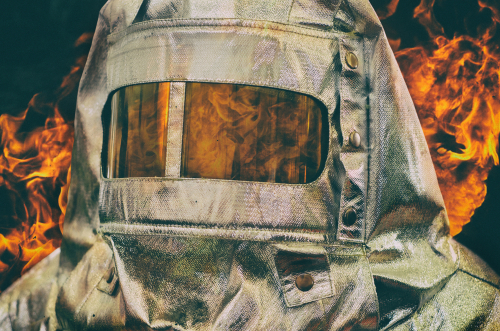
Most clothing and household fabrics will burn, regardless of what they are made of. In most cases, you don’t need a flame to start a clothing fire. If there is enough heat present, the fabrics will burn. Depending on the fibers in the fabric, they may also give off toxic smoke and fumes. In most cases, clothing fires are started by common items such as candles, matches, lighters, cigarettes, flammable liquids, heaters, or fireplaces. No matter how hard you try to pick lower risk fire fabrics, you should still know what to do if your clothes catch fire, or you see someone with their clothes on fire.
What To Do If Your Clothes Catch Fire
Your actions in the first few seconds of a clothing fire will make a big difference in how bad the burns will be. If the garments are easy to remove, then do so as quickly as possible. Never try to run or walk while your clothes are on fire. Instead, drop to the ground and roll in order to smother the fire. In a similar fashion, if you see someone else with their clothes on fire, make sure they lay on the ground and roll. You can also throw a blanket, coat, or other material over them to try and smother the fire. Unfortunately, even just a few seconds of indecision or delay can lead to serious burns. Since most garments today are made of one or more synthetic materials that will melt and leave serious burns, it is likely you will need to go to an emergency room for treatment.
Over the years, the increasing number of wool and cotton blend fabrics makes it increasingly difficult to figure out which ones are better in terms of reducing fire-related injuries. By the time you factor in inaccurate labeling, purchasing decisions can become even more complicated. At the very least, you can try to rely on labels, and then make sure that you use a burn test for items that you might use or may decide to take with you during a fire emergency. Knowing which garments or other materials will withstand fire a bit longer can reduce the severity of burn injuries, and may just save your life.


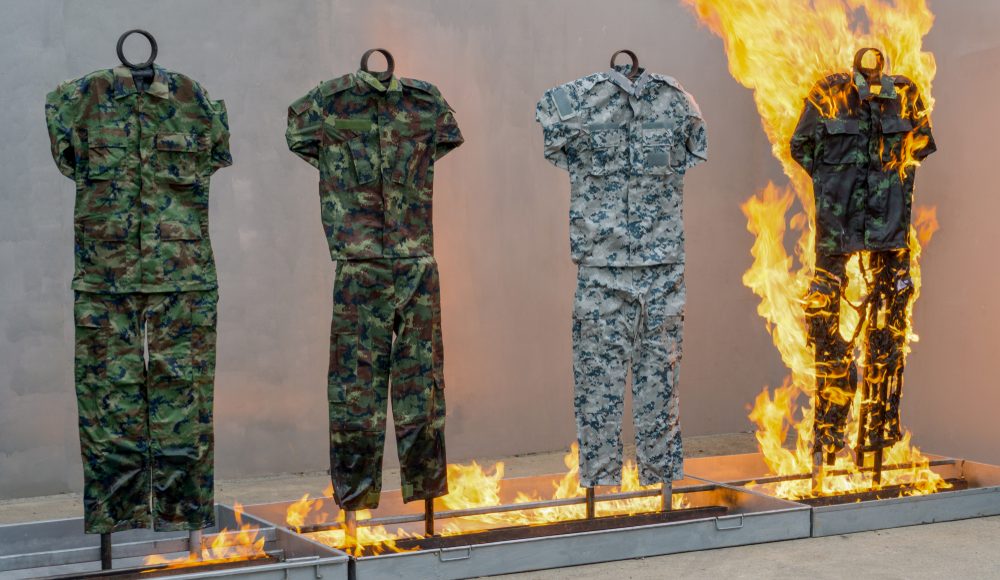





Jackie | November 26, 2020
|
Since I am allergic to man made fabric’s as opposed to fabrics organically made from materials that made from plant products with no additives I don’t think I will have problems. I only buy clothing and sheets and towels made with 100% cotton fabric I will be pretty safe. The only problem is finding clothing made of 1o0% Cotton. They would rather have you burn or die wearing their fabrics than making them of Cotton.
Bruce D. Latham, DO | April 19, 2023
|
Nomex has been used for years in the fire service and as utilities (Pants and shirt). Are there any new fire resistant product out there?